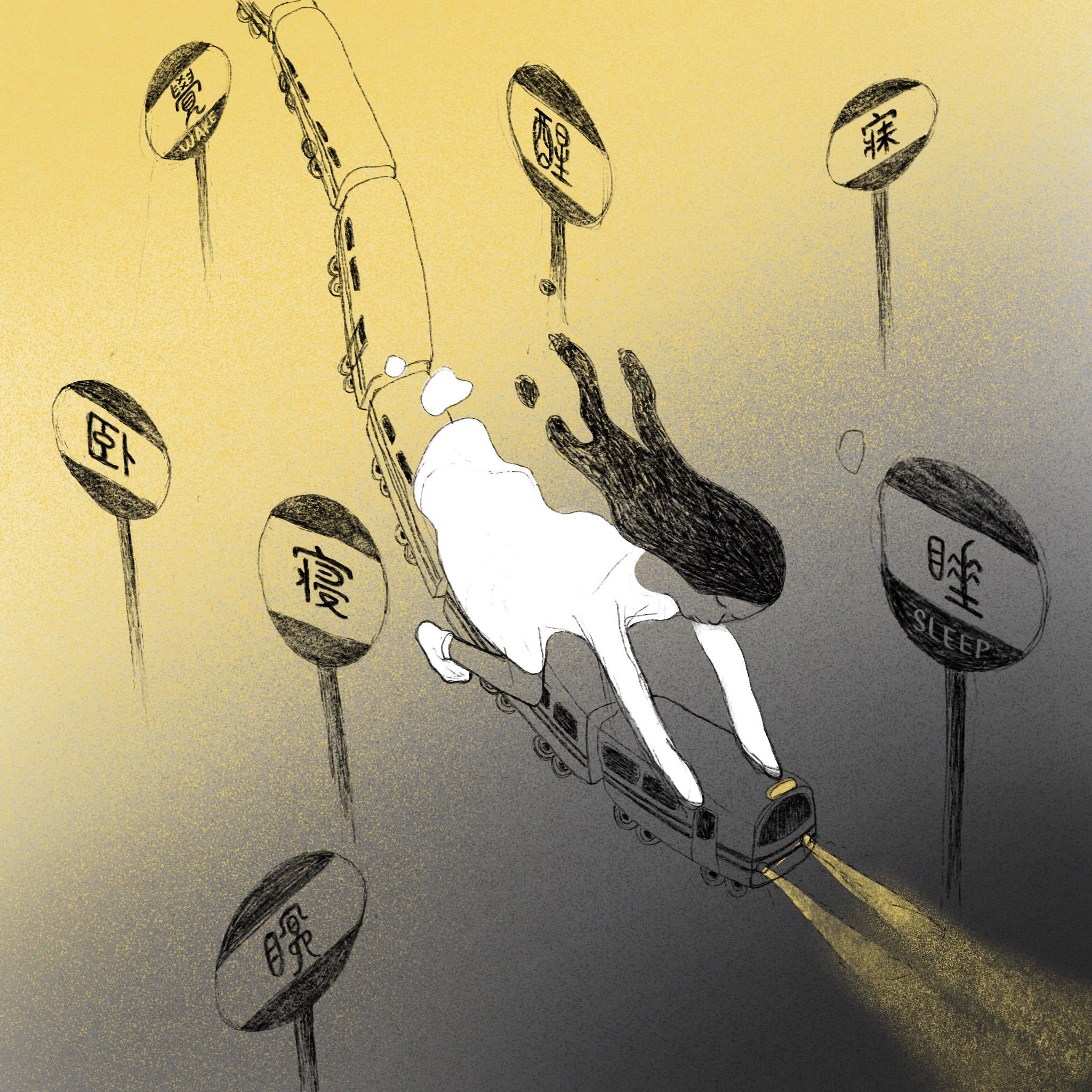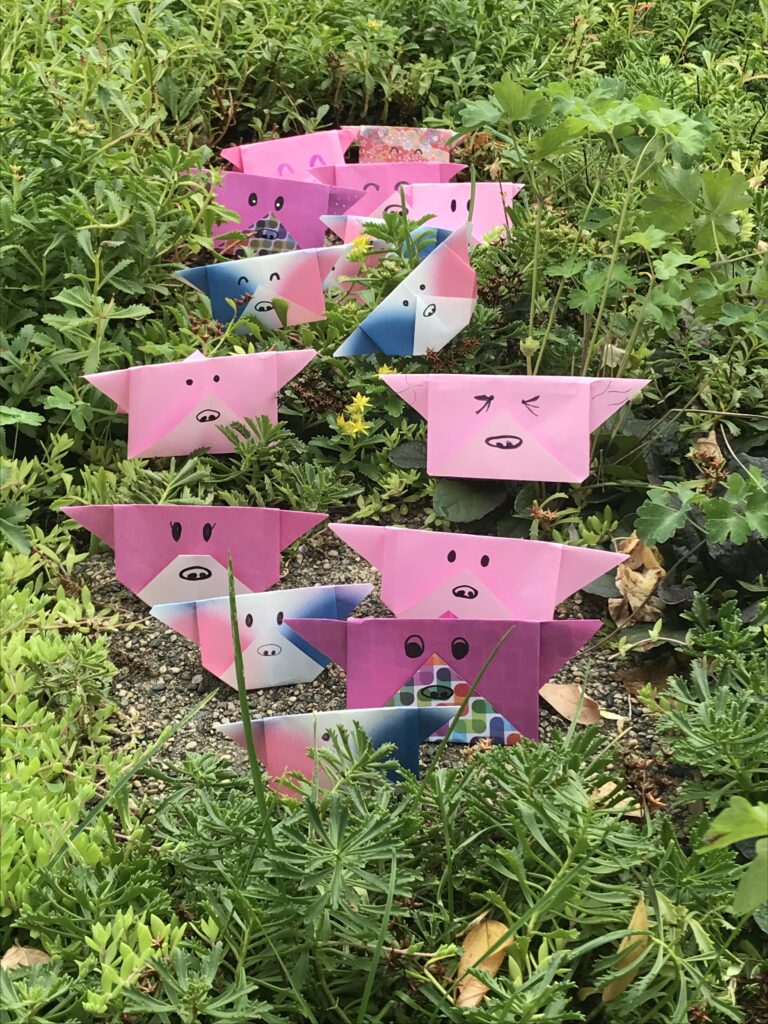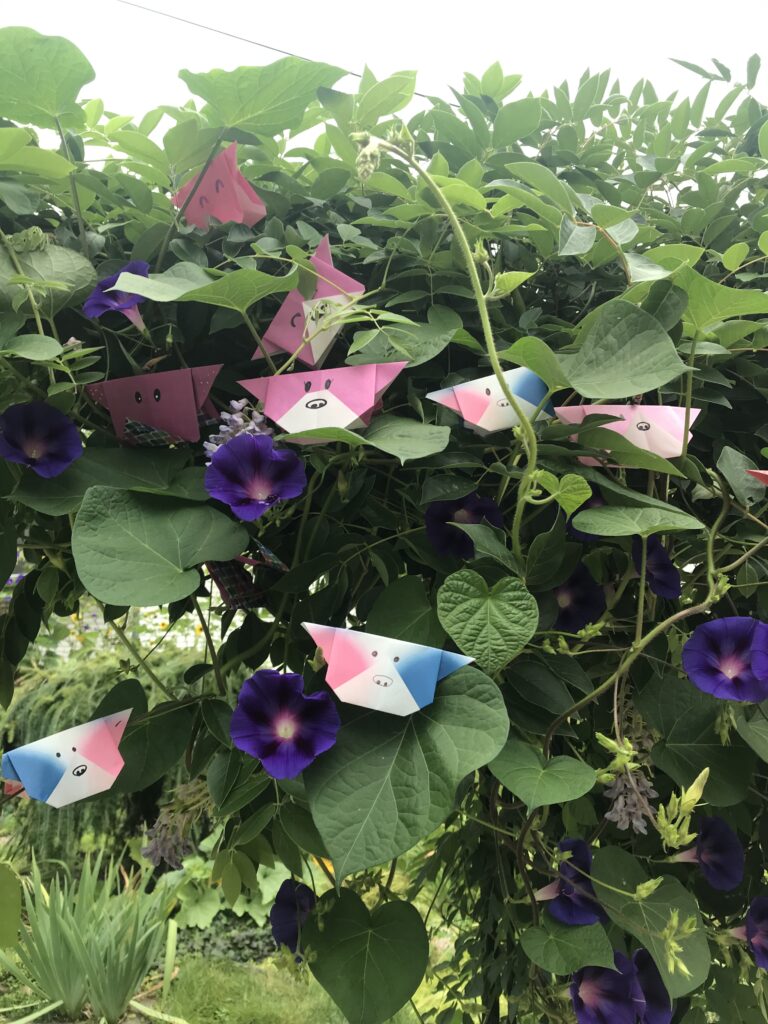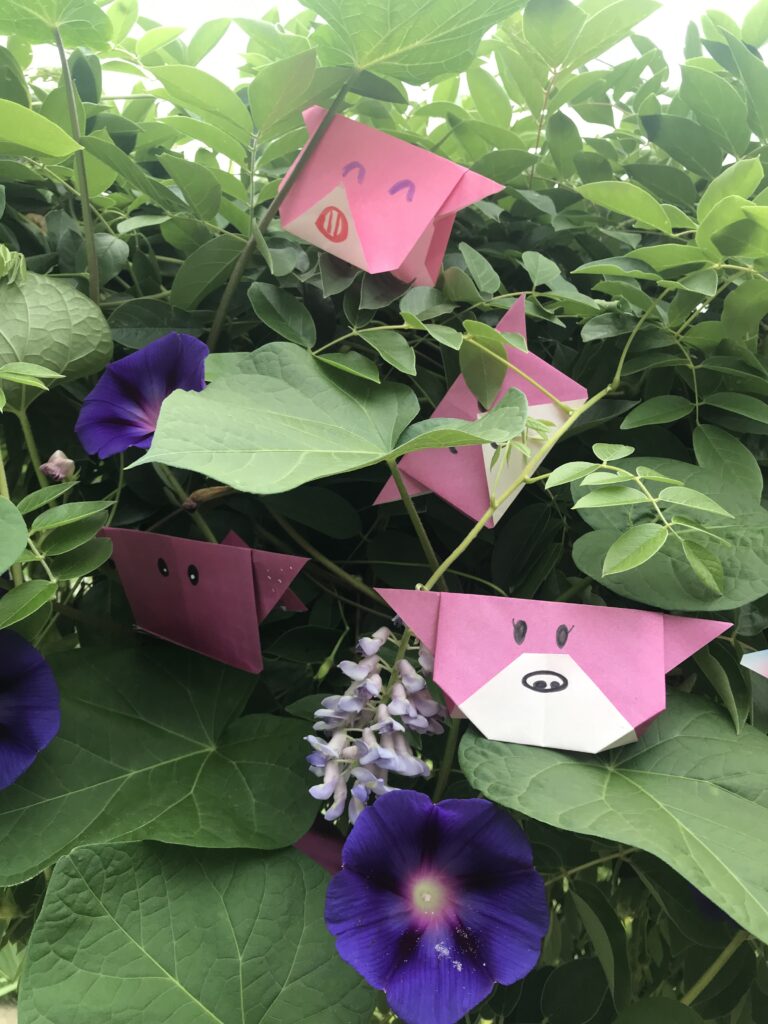Meditation on Sleep
Sleep as travel, sleep as spirit, sleep as country, sleep as grammar, sleep as diversity, sleep as hospitality, sleep that catches you

1. Sleep-Spirit
Growing up in Japan, I had believed that sleep was a certain type of force, a spirit, that entered into our bodies. Our weakened bodies had a certain scent that the sleep-spirit could sense; the spirit surrounded us and seamlessly slipped into our body. In retrospect, my imagination was inspired by the power of sleep. There was no way of not sleeping once the sleep-spirit touched us. For me, the sleep-spirit generally sat just above my eyes, pressing my eyelids with dull weight at such inconvenient times: a math class after lunch, walking home after my fencing practice, in my room trying to study for exams. Growing up in the 90s, being able to fight through the sleep-spirit was the sign of a committed individual. I constantly hid my sleepiness. I didn’t want to be seen as weak, lazy, or uncommitted.
There was one place in Japan where everyone had permission to sleep: on the trains. Most people sitting on seats were sleeping. Some passengers slept so deeply that their heads fell onto the shoulder of the stranger sitting next to them. Some passengers had their mouths wide open and I could see their gold crowns inside. Passengers rocked back and forth with the movement of the train. Those who stood hanging on the railing also had their eyes closed. It was as if the sleep-spirit lived inside the trains. At the time, seeing the deep sleep of strangers resting collectively on trains felt normal. Inside trains, we sleep. I didn’t realize how this scene would be perceived by others until I saw the surprised reaction of travelers from overseas. Why do Japanese people sleep on trains? Why are they so tired? Sleeping is what we do in a private space, yet why are they sleeping so deeply in such a public place?
On the train, we are always in between places. We have left home, trying to get to a destination. In this space of in-between, the sleep-spirit finds our bodies being carried and rocked as if we have become babies in cradles. Our alertness cracks, and the sleep-spirit finds a way into our psyche. Like a cold virus entering into our body with a weakened immune system. Instead of getting sick, we become sleepy.
2. Sleep-Language
When I came to the United States at the age of 15, I struggled with the fundamental rule of sentence formation: subject + verb + object. In English, a sentence must contain a subject in order to make sense. We must define who or what is taking the action. Following this rule, I taught myself to use the subject, “I,” which is largely dismissed in Japanese. Speaking in English requires a different mindset. Initially, it felt inaccurate, especially describing the state of sleep. “I fall asleep. I wake up.” The “I” seems to be in control when, in fact, my sleep or the state of being awake was influenced by something other than the “I.”
Worse yet, an object often needs a pronoun. People ask, “How was your sleep?” Was the sleep mine? Was my sleep different from your sleep? The essence of the question might be how I connected with sleep the night before, but no one forms such an awkward question. In English, I am constantly wondering who owns the object. “My sleep” sounded strange, as if I could own this mysterious entity called sleep. I could not simply reply, “sleep was good;” this “sleep” needed to be attached to someone, somehow. Sleep happened to me; I became awake when sleep left me; did sleep happen to you? This is the way I would speak, unconventional and grammatically wrong.
In Japanese, there are several kanji (Chinese) characters to describe sleep. The common one is sleep (睡) which is made of two characters: eyes (目), dripping (垂). “Going to sleep” or “sleeping” is expressed in just one kanji character, 寝, but it has multiple meanings: lying down, sleeping, resting, being in an ancestral, spiritual space, and quitting. How this word was formed to represent sleep reflects the depth of sleep. Connecting to sleep isn’t just about a physical motion (lying down on bed), a shift in state (from awake to sleep), or healing impact (rest.) Dreaming, which occurs during sleep, is also considered mysterious and spiritual, perhaps in a way that we get in touch with our ancestors. But most of all, sleep is about not doing, not acting. Not doing. This seemed impossible.
We travel from being awake to being asleep by “falling,” in English. What a strong motion to describe the action of sleep! In fact, falling isn’t a natural action for humans. Things that can fall naturally do seem to exist in nature: the cascade of a waterfall, raindrops falling from the sky. But for humans, falling isn’t safe. Falling requires practice, preparation, and courage. The sports that use falling, such as gymnastics, diving, and skydiving, all come with training, and even then, the risks of physical injury exist. Is falling asleep similar to the way divers jump off the board and hit the surface of the pool? Or is falling asleep similar to the way we fall in love? And when we can’t fall asleep or fall in love, is it because we didn’t jump properly? Or is it the failure of gravity?
Our expressions reveal our expectations or assumptions. The expression “falling asleep” may suggest that we can let go at ease. Unable to let go, we fail… Even though we don’t mean to judge, the way we use language discloses expectations. Linguists George Lakoff and Mark Johnson describe the orientation of metaphors as specifically influenced by our cultural and physical experiences, including directional expressions.1 Having control is often associated with “up,” as in, “I have control over you.” Not having control is “down,” as in, “I am under a lot of pressure.” Thus the expression of waking “up” may be understood as a state we have control over. We unconsciously expect people to be able to wake up and stay up. During my teenage years in the 90s, this expectation to stay up and not be lazy was verbally expressed by adults in my life. It still lives in the way I use language today.
In English, I feel responsible for the act of sleep. “My” sleep is determined by the way I fall. In Japanese, I am hoping the sleep-spirit would find me at night and not bother me during the day. The travel between being awake and falling asleep makes me feel as though I am an immigrant to the country called sleep. To enter into this country, I stand in a long line holding my passport, hoping to be granted permission to walk through the gate. In this sense, “falling” hardly explains the way I arrive in the sleep country. I wait, wait, and walk through the gate, into sleep.
3. Sleep-Space
If the navigation of being awake and falling asleep resembles the life of immigrants, perhaps humans are all immigrants traveling back and forth between those two countries every day. Back in 1901, Edith Franklin Wyatt, a poet and social activist, expressed wonderment on traveling to sleep:
Sleep Where do I go Down roads of sleep, Behind the blue-brimmed day? No more I know her silvered sweep Nor colors clear nor gray, Nor women’s ways Nor those of men, Nor blame, nor praise. Where am I, then?2
Wyatt’s description of sleep as a place reminds me of the disoriented state of my mind when I travel internationally. “Where am I?” is often my first thought when I wake up on the first day I arrive in Japan. Waking up on my futon on the tatami floor, I don’t feel as though I know where I am. Of course I know where I am, but I’m not where I think I am. It could be jet lag or the exhaustion from the long flight from the United States. But mostly, this sensation comes from having moved from one world to another. Just yesterday, I was in the United States. Now I am in Japan. Logically, everything makes sense. Yet emotionally, this shift feels like falling into a gap that I have no name for. It feels upsetting, yet I am not really upset. For a few days, this feeling of not knowing where I am lives inside me. I see crowds of Japanese people with serious gazes passing by, and they all have black hair. Then I look at myself and realize that I, too, have black hair and look just like those Japanese people. I have always known that my hair is black and that I look Japanese. Noticing how surprised I am by the reality I had known for all my life makes me question if I am really awake.
Immigrants often talk about becoming foreigners to their own country and that they are always in between. They are always on the trains. They live with this sensation of wondering if they are really awake and here. As we sleep, we are not going anywhere, yet we are in a different space. The complex thoughts we held are still inside us, but there is a distance from these thoughts. The distance I feel from my own country while still being the native of that country feels like the sleep-space Wyatt described: “Nor colors, clear nor gray/Nor women’s ways/Nor those of men.” The neutrality of this space may feel open and vast. It may feel a bit lonely, but it is also freeing, as if this in-between space is a truce between the new and old countries.
4. Sleep-Truce
Recalling the toxic message that getting sleepy was a sign of an uncommitted, lazy individual, I am dumbfounded today. Such fundamental information about what we all do, sleep, was communicated in a harmful way. Sleep is both a necessity and a gift. This is vividly expressed by the Argentine writer and poet, Jorge Luis Borges, in the beginning of his poem, “Sleep.”
Sleep If sleep is truce, as it is sometimes said, A pure time for the mind to rest and heal, Why, when they suddenly wake you, do you feel That they have stolen everything you had? It strips us of a gift so strange, so deep3
I sense the anger, grief, and shock at the moment of waking up from Borges’ expression. When we return to the world of being awake, it feels as though everything was stolen from us. I imagine that many could relate to the grief from leaving the sleep space.
Not taking a break from being awake can kill us. This is true for all, but urgently true for those who struggle with mental health issues. From the moment they wake up, they work with their own thoughts and feelings, infused with sharpness, heaviness, darkness, numbness, and emptiness. How difficult it is to be awake with all these thoughts and feelings… “If sleep is truce, […] a pure time for the mind to rest and heal,” not being able to get to this time is a burden. And the journey back from sleep to return to these thoughts and feelings isn’t easy. Without the sleep-truce, the sense of helplessness and hopelessness easily overfills them.
“I just don’t want to be here anymore.”
This is the statement I often hear from the adolescents in psychiatric treatment for whom I facilitate creative writing workshops. Listening to their writing, it is as if they have become immigrants to their own beings. They don’t want to be themselves. They don’t want to live in their bodies, minds, beings, on this earth. But if not here, where can they go? We can never walk away from ourselves, yet what is inside us, the accumulated negative thoughts about ourselves, have hardened and are hurting us. Suicidal thoughts emerge and float constantly on the surface, as death seems like the only way out of this constant pain.
Loosening what has hardened inside them is the daily practice of adolescents with mental health issues. I imagine them sitting with the ropes of negative thoughts and patiently untying the tight knots. In the midst of this hard work, sleep might be one way to take a break from their own being. If so, how do these adolescents travel back and forth between being awake and being asleep? Is it as easy as “falling,” or as unpredictable as “catching,” which is the way I find my sleep? This question led to, first, writing a poem about my own process of finding sleep.
Sleep Mantra
Pretty Pink Paper Pig Penelope.
I repeat.
Pretty Pink Paper Pig Penelope.
Still, I’m not falling
asleep. I want to fall
asleep, but so many ideas (good and bad)
find me and sit in front of my brain like a friend
waiting on the front step.
I don’t say, let me sleep because if I do,
I’d get mad for not catching my sleep.
So I close my eyes.
I begin folding a pink piece of origami paper inside my head until it becomes
a pig, Penelope,
who is as neutral as oxygen, who holds no
opinion about the way I sleep—
I fold her again and again,
like a prayer repeated,
until it’s all Penelopes
in my mind.

Photo: Yuko Taniguchi. 
Photo: Yuko Taniguchi. 
Photo: Yuko Taniguchi.
Then I read it out loud to the adolescents during my writing class. I could hear the playful sound of my own sleep mantra, which doesn’t have any meaning, but the silly sound comforts me. I explained how I think of sleep as something that I have to catch, but when I try to catch it, I can’t. Instead, I need to wait to be caught by sleep.
“How about you? How does your sleep arrive?” I asked. I encouraged everyone to select a simile to describe what the arrival of sleep is like. What the adolescents shared was vivid, imaginative, and deeply authentic.
It is like snow because sleep never arrives when the room is too warm; each snowflake accumulates to create a snowbank which is the form of sleep. Or sleep appears the way the sun appears after a storm passes. But many expressed that tremendous patience is required of them to get to their sleep. Sleep is like watching wet paint drying, yet no matter how long they wait, it never gets dry. Sleep is like a bee flying around with a buzzing sound; they are afraid of it yet they can't catch it. Sleep is like a train that is leaving the station; they run to try to catch it, yet the train continues to run fast enough that they cannot reach it. Sleep is like climbing a mountain that has no peak. Sleep is like running through hard rain, shivering, trying to find shelter.
In their words sleep is, indeed, a spirit. It teases them with the promise of rest, yet to actually get to the sleep-space seems impossible.
Still, listening to each other’s words on sleep, its movement and arrival felt deeply meaningful. There is so much beauty in their expressions. They created their own and precise sleep-language to describe the search and travel to get to the sleep space.
5. Sleep Mantra
“What kind of imagination do you think might help you fall asleep?”
I invite the adolescents to explore this question. “If sleep is truce, […] a pure time for the mind to rest and heal,” yet we cannot get there, the alternative place seemed to be our imagination. What is soothing and comforting is different for every person. What do we imagine while we wait for the sleep-spirit to enter into our psyche?
Repetition might be my modality. Inside my mind, I fold pink origami paper into a pig. It only has nine folds. I need something simple to be repeated in my head. But hardly anyone had the same thought.
Paying attention to the crack of the window and imagine how the soothing wind is coming and touching their face. Listening to the rain hitting the roof as if to give the heartbeats to the house. Meeting someone famous yet having a low-key conversation about something real because famous people don’t always get to talk about ordinary things. Not counting but picturing the numbers and seeing them float in their minds.
I was invited to all kinds of magical spaces filled with details related to a path to sleep. I also thought about one of the definitions of sleep in the Japanese kanji character, 寝 (sleep): “not doing.” If our mind holds sharp thoughts inside, we can sit next to this sharpness. Sit quietly. Don’t rush. Imagine and observe what captures our attention enough without becoming too rigorous. Wait for the sleep-spirit to find us.
6. Sleep Diversity
I first heard the term “sleep diversity” from Peng Wu, an interdisciplinary artist who creates social practice and participatory opportunities for social change, and Dr. Michael Howell, an associate professor, researcher, and expert in the relationship between sleep and the brain in the Department of Neurology at the University of Minnesota. Wu and Dr. Howell collaborated for a year to explore ways to enhance sleep therapy by applying both scientific and artistic perspectives. Wu also has trouble with his sleep. Thus this collaboration also included a patient’s perspective. During their collaboration, they examined the culture of sleep. Dr. Howell commented, “The most important unrecognized form of diversity is circadian diversity.”
Sleep diversity: everyone sleeps differently.
This simple and obvious concept isn’t in the collective awareness. Rather, there is a common narrative of the majority: at night, we fall asleep, and in the morning, we get up. Wu and Dr. Howell described that people who do not fall into the common narrative blame themselves. Being awake in the middle of the night, they tell themselves, “I should be sleeping now.” They close their eyes, try harder, and become frustrated. “I need my sleep. If I don’t get it, I will suffer through work again tomorrow.” They become worried and anxious. Lying down in bed, they tell themselves, “I can’t do what others can so easily do: fall asleep.” Feeling inferior and alone, they are farther away from the sleep truce.
Language matters. This means we each have to invent our own sleep-language to accurately reflect the way we sleep, find sleep, and comfort us while we wait for our sleep’s arrival. What if everyone began describing their sleep in their own way, as the adolescents in my creative writing class did?
7. Sleep Hospitality
Growing up in Japan as the daughter of parents who hosted many dinner parties, my mother taught me the art of hospitality. I learned that a dinner party begins before people gather by preparing food we know they will like—safe food—and food that they can try and may like—adventure food. A successful dinner party begins the moment the guests walk into the dining room. They arrive, knowing that they have been thought of, and that the host is aware of their preferences. Then they walk to the dining table filled with beautifully presented and arranged food. They see that they have options. When being cared for, beauty and flexibility are combined, magically, and the dinner tastes delicious. In order for food to become delicious, guests must feel safe, comfortable and accepted, including those that cannot eat certain foods.
I have come to think of sleep diversity through the lens of hospitality. Understanding that people sleep differently can be like a dinner party with a caring host. Growing the awareness of sleep diversity needs beautiful and thoughtful experiences and vivid descriptive writing rooted in imagination. The content might express difficulty, but each paragraph is uniquely precise, and thus beautiful.
Falling asleep, an important and necessary ritual we enact every day, requires attention, care, and our own authentic expression. Imagination helps us reflect on the shape of our sleep. Healing begins by bypassing all the layers of judgmental narratives, finding our sleep language to describe our experiences.
Walking down the street, I see many houses with signs posted: “All are welcome here.”
The same is true for sleep. All are welcome.